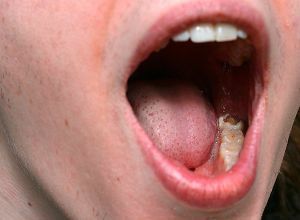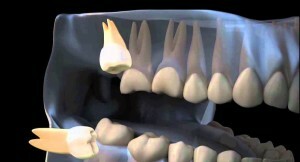 Eight, they are wisdom teeth, more often their "fellows" on the dentition suffer from dental diseases, among which pulpitis is often diagnosed.
Eight, they are wisdom teeth, more often their "fellows" on the dentition suffer from dental diseases, among which pulpitis is often diagnosed.
Feature and at the same time the complexity of the wisdom tooth lies in its location and strong curvature of the roots. Because of difficult access, the eight are more often removed than treated.
Why is the "wise" pulp inflamed?
Pulpitis is the inflammation of the nerve of the tooth. The disease can occur for various reasons, the main one of which is the advanced stage of caries. In this case, the disease is so progressive that the destruction of the crown of the tooth reaches the root itself and affects the nerve.
A person can for a long time not pay attention to the presence of tooth decay, as there is no special inconvenience, and the wisdom tooth's invisibility due to its location makes it even more difficult to detect pulpitis early in the early stages. However, deep  lesions of nerve endings immediately make themselves felt. There is a strong pulsating or aching pain( depends on the form of the disease), which is long tolerated by very few people will succeed.
lesions of nerve endings immediately make themselves felt. There is a strong pulsating or aching pain( depends on the form of the disease), which is long tolerated by very few people will succeed.
Another factor that provokes the appearance of pulpitis may be unprofessional dental surgery. Among the most common mistakes is poor-quality sealing and perforation during dental treatment.
Pulpitis has the following varieties depending on the stage of development:
- acute;
- chronic;
- chronic with exacerbation.
Depending on the affected area, the following subspecies of disease are distinguished:
- coronary;
- total;
- root.
Injuries to the tooth also provoke the appearance of pulpitis. They can be diverse - cracks in the enamel, fracture of the tooth, breakage of the crown. There are holes and cracks through which germs of streptococcus, staphylococcus, lactobacillus penetrate into the basis of the tooth - root pulp.
Sometimes, temperature or chemical factors can trigger an inflammatory process in the basal area. The chemical material of the inserted seal can be rejected by the body. There is a toxic reaction, which leads to infection of the pulp chamber. To prevent such situations, when sealing channels, an insulating spacer is applied.
Gingivotomy and gingivectomy are traumatic operations that can trigger the development of pulpitis.
But much more often the inflammation of the pulp occurs because of caries started. If it is not cured in time, then the damage to the tooth tissues deepens, down to the roots.
Is not all the pulpitis that hurts in the mouth?
Symptoms are practically the same, depending on the location of the tooth. A mandatory symptom is a strong toothache. She  arises involuntarily, it would seem, without any special reason. Strengthens at night. With the development of destruction and the intensification of the inflammatory process, the pain syndrome becomes stronger, it can become intolerable. Some people have painful sensations of aching, appear for a while, pass.
arises involuntarily, it would seem, without any special reason. Strengthens at night. With the development of destruction and the intensification of the inflammatory process, the pain syndrome becomes stronger, it can become intolerable. Some people have painful sensations of aching, appear for a while, pass.
When exposed to hot food and drinks, the pain intensifies many times, while the cold products, on the contrary, soothe for a while.
The nature of the pain depends on the degree of development of the disease. In the initial stages it is aching, not strong, it can only bother at night. An acute form is accompanied by a strong stitching pain. Every day it gets worse, discomfort and soreness can not pass at all, and at night not to close your eyes.
Often the patient can not determine which tooth the pain comes from, as it extends to neighboring areas, the whole jaw, half the face. The temperature rises, the sensitivity becomes extremely high.
In the chronic form of pulpitis, pain syndrome may be absent. From time to time, there is an exacerbation of the condition, which is accompanied by all the symptoms of an acute form.
What is the complexity of the treatment and extraction of
? With pulpitis of the wisdom tooth, all the symptoms, as well as the course of the disease, are the same as in the case of another localization of the inflammatory process, however, the treatment of the third molar is much more complicated. The reason lies in the location.

Retention is a matter for 8-to-ordinary, cure such tooth is unrealistic
Most people are not able to open their mouths wide so that the dentist can get quality access to the required area. In addition, in many people, eight are only partially erupted.
The complexity lies in their incorrect location. Third molars can erupt under a strong slope. In such situations, their value for the chewing function is zero, since they do not participate at all in the process of chewing food. But they will permanently injure the mucous membrane of the oral cavity, sometimes causing harm to the roots of neighboring teeth.
To cure a wisdom tooth is not so easy due to the following factors, characteristic for 8-to:
- root curvature;
- complex location;
- incomplete cutting;
- curve growth.
It is preferable to immediately remove the problem wisdom tooth, but if complicating factors such as curvature and partial eruption are not present, and the roots are well passable, then pulpitis can be tried to cure if such a desire is present in the patient.
Before you start treatment, you need to weigh all the factors. In many cases, removal is the best option.
The fact is that in most people the third molar grows crookedly, rests against the cheek or the adjacent tooth. With this arrangement, the chewing function is completely absent, and the "sage" can harm the adjacent tooth or create a permanent wound on the mucosa. It should not be left even in a healthy form.
If nevertheless the decision on treatment is accepted, then perform depulpation. This procedure involves the removal of the dental nerve and the subsequent filling of the root canals.
Of course, it is desirable to keep the nerve alive, but this is possible only at the initial stage of the disease. In this case, the patient should not be older than 25 years, because only at a young age the pulp can recover.
Pulpit wisdom tooth can be cured at the initial stage of the disease, if there is no deformation, and the root canals are easily passable. But more often people turn to dentists at the advanced stage of the disease, when the only option is removal.
